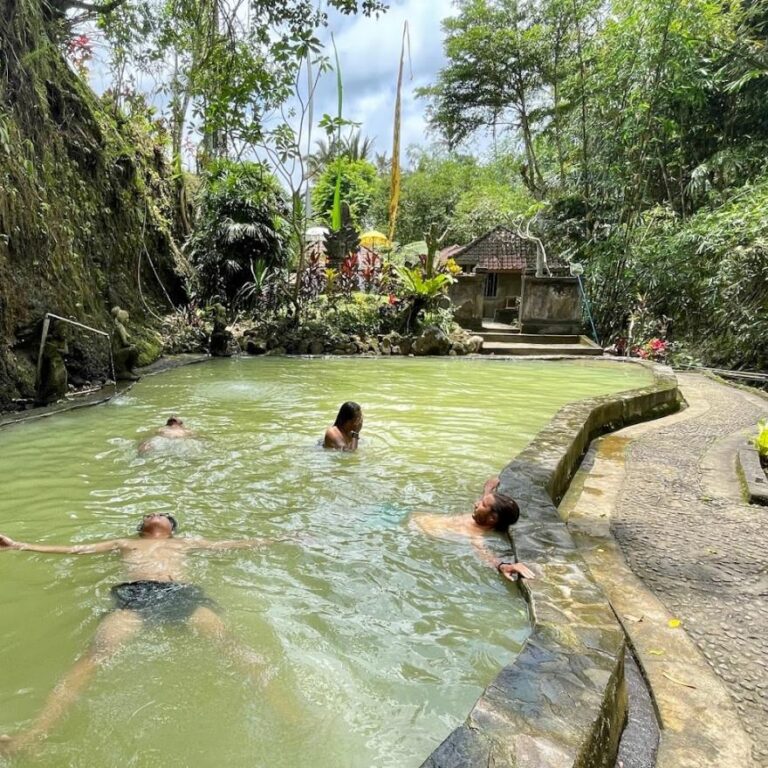The Gates of Heaven and Bali aren’t mythical things. They’re part of the Pura Lempuyang temple complex in East Bali.
It’s one of the most revered temples on the island, and it can be found on the slopes of the mighty Mount Lempuyang.
It’s one of the “six sanctuaries of the world”, the Sad Kahyangan Jagad and thus, one of the holiest places in Bali.
Lempuyang Temple and the temple grounds are open to the public, and you can visit this awe-inspiring temple. Our guide will tell you what to expect and how to get the most out of your trip to the Gates of Heaven, Bali.
What’s The Name Of This Temple?
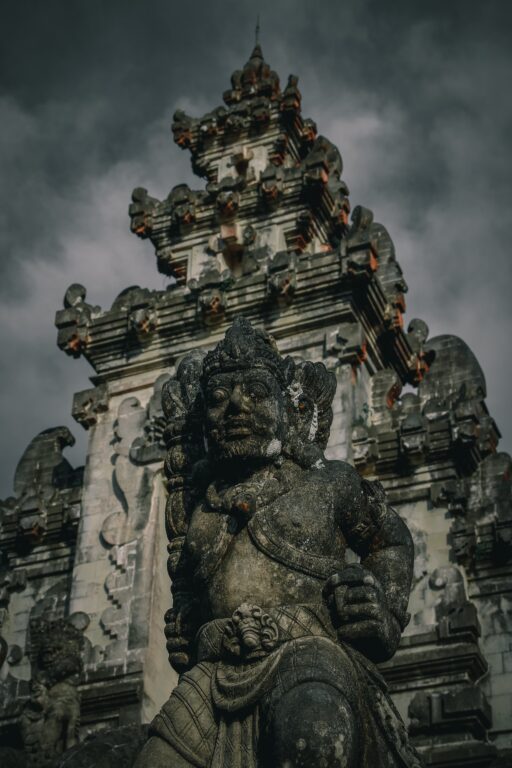
It has various names depending on how formal you want to be, from Pura Telaga Mas Lempuyang to Pura Penataran Agung Lempuyang, to Pura Lempuyang Temple to Lempuyang Temple.
The names are various constructions around the location of the temple and its functions. Pura Penataran Agung Lempuyang refers to the complex of temples on the Lempuyang Mountain opposite Mount Agung, for example.
We’ve used various forms of the names throughout this article to help you get used to this quirk of Balinese naming culture.
Where Is Pura Lempuyang Temple, Bali?

The Lempuyang Temple Complex is found on the slopes of the temple’s namesake Mount Lempuyang. This is in the Karangasem Regency of East Bali.
If you intend to visit Lempuyang Temple, you might want to consider spending a night or two in the nearby town of Amed (also in East Bali), as it’s quite a long drive from the coastal resorts of Kuta, Seminyak, Legian, and Canggu.
How do you get to Pura Lempuyang Temple, Bali?
You have several options to get to the temple complex.
We’d recommend that you visit Lempuyang Temple either on a private tour, which will collect you from your hotel and ensure that you have a guide on the head to get the most out of your experience at Pura Lempuyang Temple, or that you hire a private driver.
A private driver is often the best way to get around Bali in general, but here, it’s probably the second best option as while your driver will be happy to take in other sights as required and watch over your things, they can’t usually give you a good guided tour of the Lempuyang Temple complex.
You could also take a scooter, but we don’t recommend visiting Lempuyang Temple on a scooter.
Not only do all of our usual caveats about the roads, staying legal, etc. apply (scooters are the leading cause of holiday accidents in Bali), but the road to the temple entrance is very steep, and you may find that your scooter really struggles to get there.
If you do go by scooter, be aware that the last few miles may take you much longer to drive than you’d anticipated.
Overall, it’s best to visit the Gates of Heaven rather than to enter them during your holiday – so it’s going to be best to take a tour or a car to Lempuyang Temple.
When Is The Best Time To Visit Pura Lempuyang Temple?
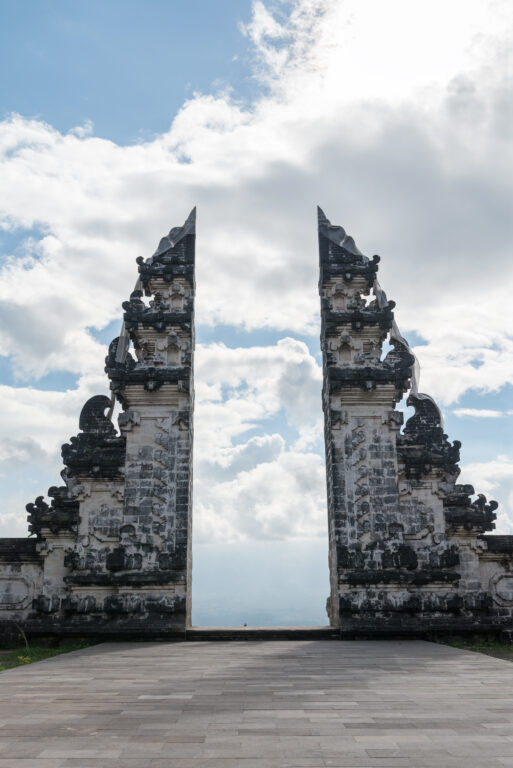
We are of the opinion that there’s no best time of year to visit Lempuyang Temple.
However, there’s no doubt that if you want the perfect Gates of Heaven, Bali shot and you don’t want to queue for it, the earlier you arrive, the better.
This is also sound advice for avoiding the crowds that arrive later on in the day and for photographers who may find they get their best images in the golden hour light of dawn.
However, we have to admit that the Gates of Heaven also look amazing when bathed in the light of a Balinese sunset.
This can add some real drama to the temple scene by creating additional shadows and highlights.
So, really, there’s no bad time to visit Lempuyang Temple. You’re assured of a spiritual and interesting experience at any time of day, nearly all year round.
What Are The Opening Hours Of Pura Lempuyang Temple?

Pura Lempuyang’s opening hours are 7 a.m. to 7 p.m. That’s more than enough time to explore the whole complex and enjoy the views, etc.
For local Hindus, the temple is open 24 hours a day to enable them to seek spiritual communion without being disturbed by tourists.
This is vital as Hindus believe that they should connect with the divine on their own terms and that their connection with the gods should not depend on temporal constraints.
However, the temple (as with everything else in Bali) is closed for the day of Nyepi (the Balinese New Year in March), and the opening hours may be amended for festivals and local events.
How Much Is The Entrance Fee To Pura Lempuyang Temple?
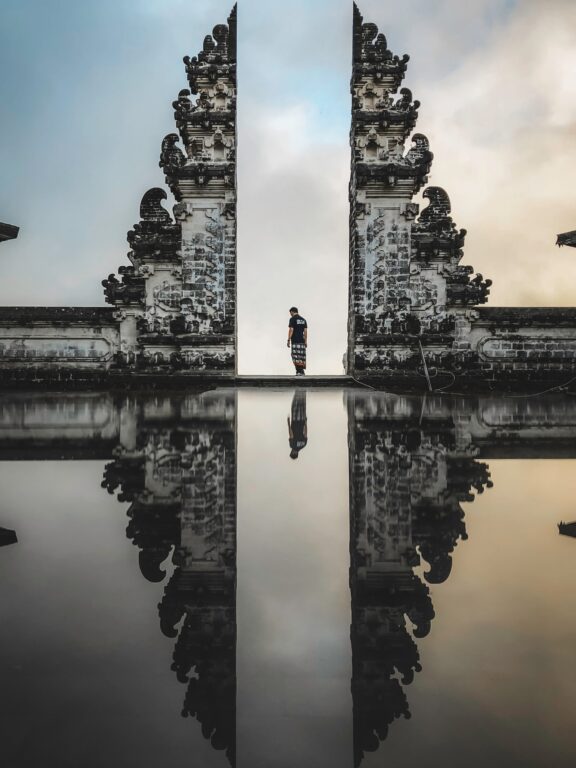
The entrance fee to Lempuyang Temple is 100,000 IDR per person. This might sound a little steep, but it does include the services of a private photographer who can help you get that perfect Instagram shot of the Gates of Heaven.
We really like this and think it makes for real value for money. We’re not saying that all Hindu Temples should provide a photographer in the entrance fees, but it’s a nice touch here.
The Gates of Heaven is one of the most iconic shots in Bali, and having your photo taken by somebody who knows how to get the most out of it is a real blessing.
You can then focus on the main temple without worrying about whether you nailed the shot.
How Much Is The Shuttle Bus For Lempuyang Temple?
However, one thing that the fee for Lempuyang Temple doesn’t cover is the shuttle bus, which will cut down on the amount of walking that you will do.
It picks you up from the car park and takes you to the temple entrance for a fee of 50,000 IDR per person.
We can strongly recommend this service as you’re going to have to climb a lot of steps at Lempuyang Temple already, so there’s no need to try to add more walking to the trip.
Also, we’d encourage you to wear comfortable shoes for walking and climbing in, and this isn’t a place for high heels or thongs.
What To Expect At Pura Lempuyang Temple?
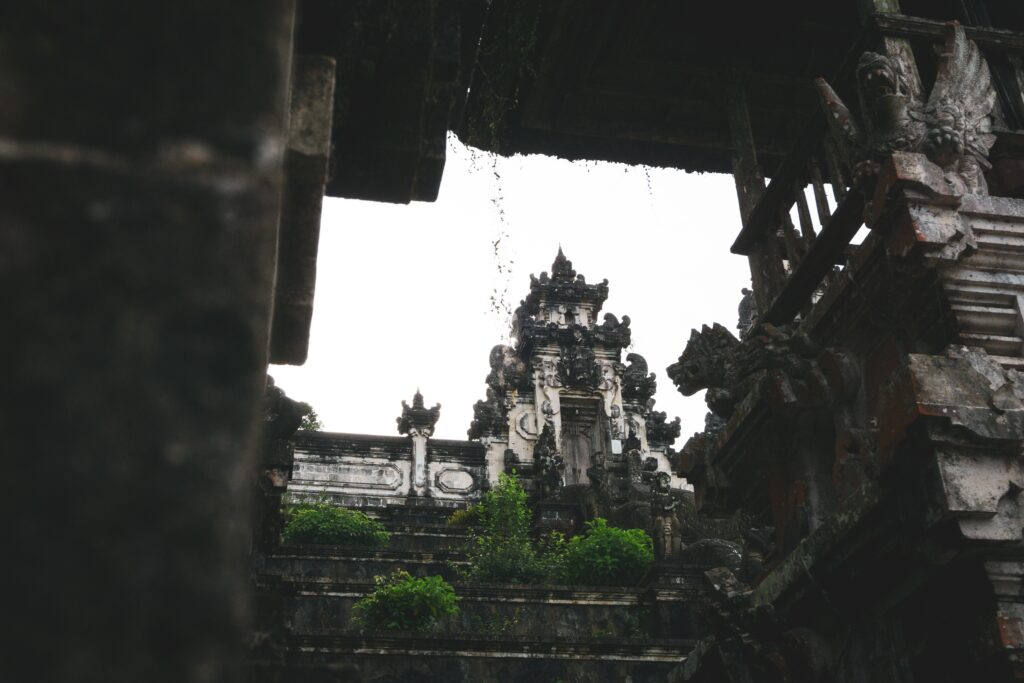
From the temple entrance, you will start to climb a long series of stairs (the exact number of stairs isn’t known – each count seems to vary, but there are around 1,700 or so).
Fortunately, you don’t have to tackle all the stairs at once, and you can stop at the series of temples that line the paths up the mountain.
This is a great way to catch a breather but also to enjoy the spiritual aspect of the place you’re visiting.
The star of the show at Lempuyang Temple is the Gates of Heaven (and they are found at the first temple you come to on the staircase), but there is plenty more to see at this beautiful site, and the countless photos of the Gates of Heaven on Instagram shouldn’t leave you thinking that this is all there is to see.
The History Of Pura Lempuyang Temple

Lempuyang Temple predates most of the Hindu sites of worship in Bali and it is believed to have been founded by Mpu Kuturan (a holy man attached to the court of King Udanya) in the 11th century AD.
Like all the “Pura Sad Kahyangan” temples (that is, the six sanctuaries of the world), it was built with the intention of protecting the Balinese people and assisting them with properly obeying religious instructions.
Legend says that a piece of the holy mountain, Mount Mehru, was brought to Bali and broken into three pieces to form Mount Batur, Mount Rinjani and Mount Agung.
However, there were still fragments left over, and they were used to form all the interconnecting mountains, including Mount Lempuyang.
These mountains are considered to be physical manifestations of gods, and thus, they are literal gods guarding the island from harm.
According to Balinese scripture and records, in 1072, the mountain was called the Adri Karang Mount, and the Jayasakti King came to the area to meditate.
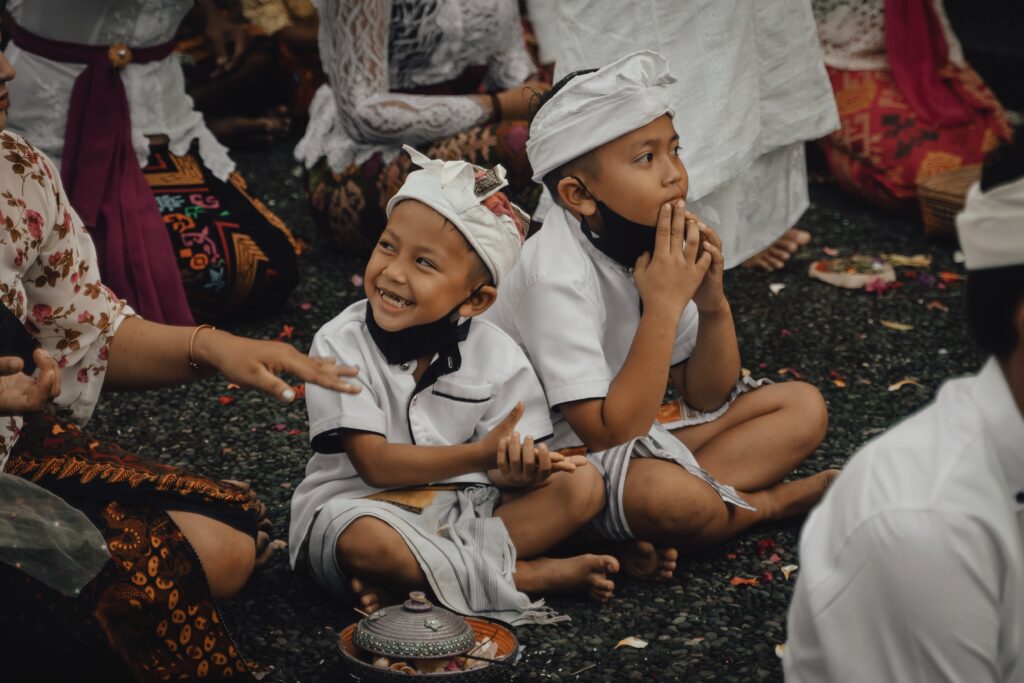
He was ordered by his father to build the temple there and to make the area around the Lempuyang Temple both prosperous and safe. He is thought to have involved Mpu Kuturan in this process.
In addition to its function of providing spiritual balance to the island, the temple is also one of a group of temples here called the Pura Kahyangan Padma Bhuwana.
That means it marks one of the eight cardinal directions, and as Pura Lempuyang Luhur (the name of one of the temples that form this complex), it represents “purwa” or “East”.
The Pura Lempuyang Luhur is also associated with a Balinese god, Iswara, which is the “personal god” or “supreme being” in Hinduism.
However, while Lempuyang Temple and Pura Lempuyang Luhur may have a long and rich history.
The temple has not escaped the ravages of the years unscathed, and it was fully restored by a local restoration project in the early 2000s.
Architecture And Design Of The Lempuyang Temple
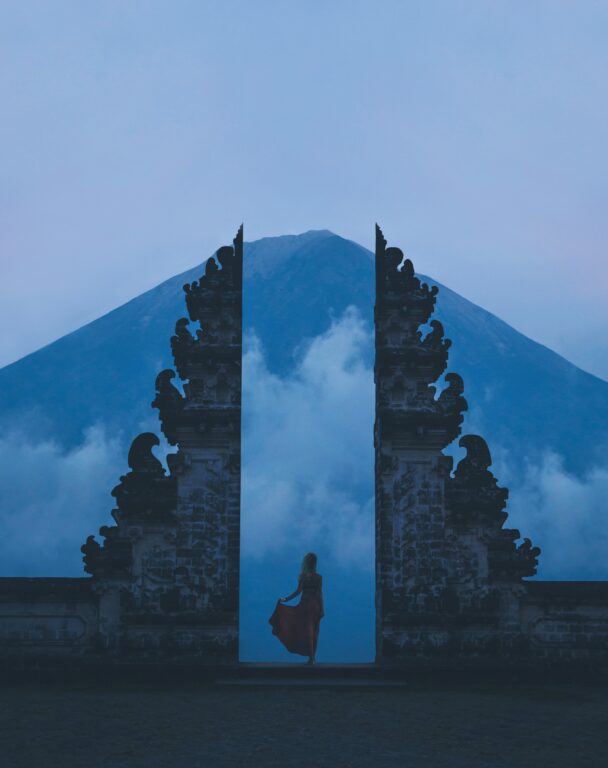
There is a lot of meaning to be found in the architecture and design at this site, including:
Structural symbolism – each temple (there are seven temples in total) is laid out at a different elevation on the mountain. This helps to simulate the spiritual journey from our earthly realm to the higher realms occupied by divine beings.
Gates of Heaven – these are a metaphor for the connection between the natural world and the divine.
Spiritual narratives – the carvings that decorate the walls and gateways tell the stories of Balinese and Hindu myth of the battle of good against evil and the devotion of those who crafted this work for the temples.
Purity – the spring at the heart of this complex is core to the Balinese belief in the cleansing power of the island’s waters. The inner sanctum offers a place for people to purify the physical as they renew their spirits.
Our place in the cosmos – the layout of the temple is also crafted to align with the stars. It creates a place for the divine energy to come in contact with this Earth.
Sacred Ceremonies & Rituals At Lempuyang Temple

This isn’t a museum; it’s a living temple, and there are several rituals and ceremonies that take place here, including:
Purnam and Tilem – the full and half moon bring worshippers to make offerings of flowers, fruit and rice to honour the goods and to seek their blessing for their lives, families and community.
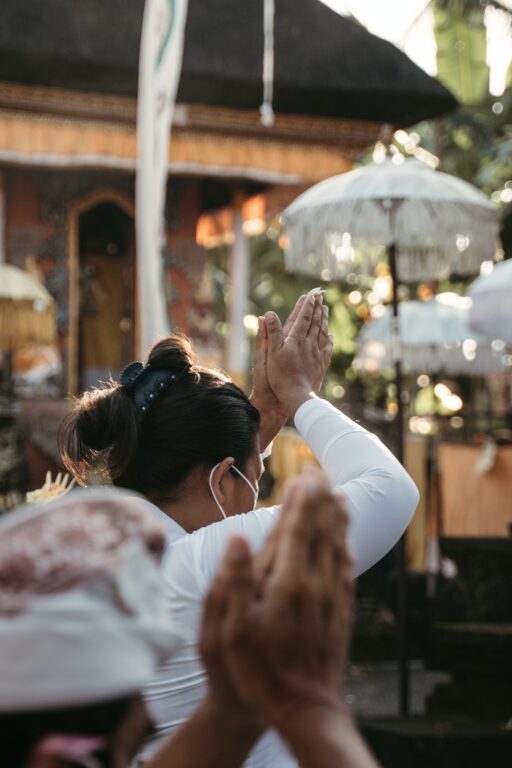
- Galungan and Kuningan – the Galungan festival marks the time when dharma (good or righteousness) triumphs over adharma (evil). Kuningan comes ten days later and commemorates when the spirits of the ancestors return to heaven. There are often traditional dances at this time of year.
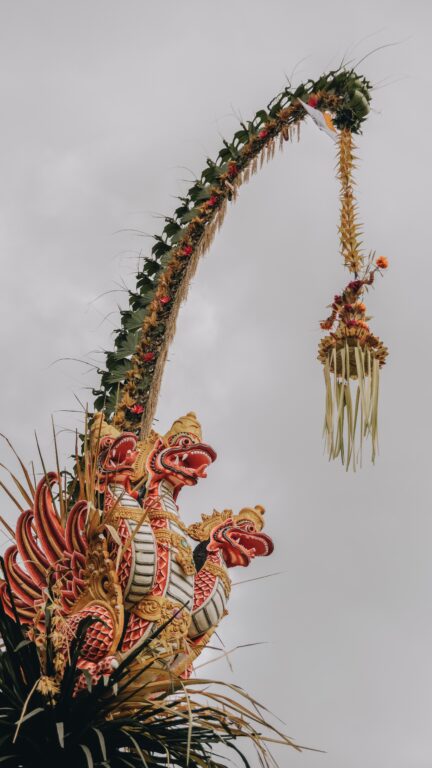
- Odalan – The temple anniversary comes once every 210 days, and many vibrant and exciting rituals are performed at the temple.

- Melukat – these are rituals of purification carried out in the temple springs.
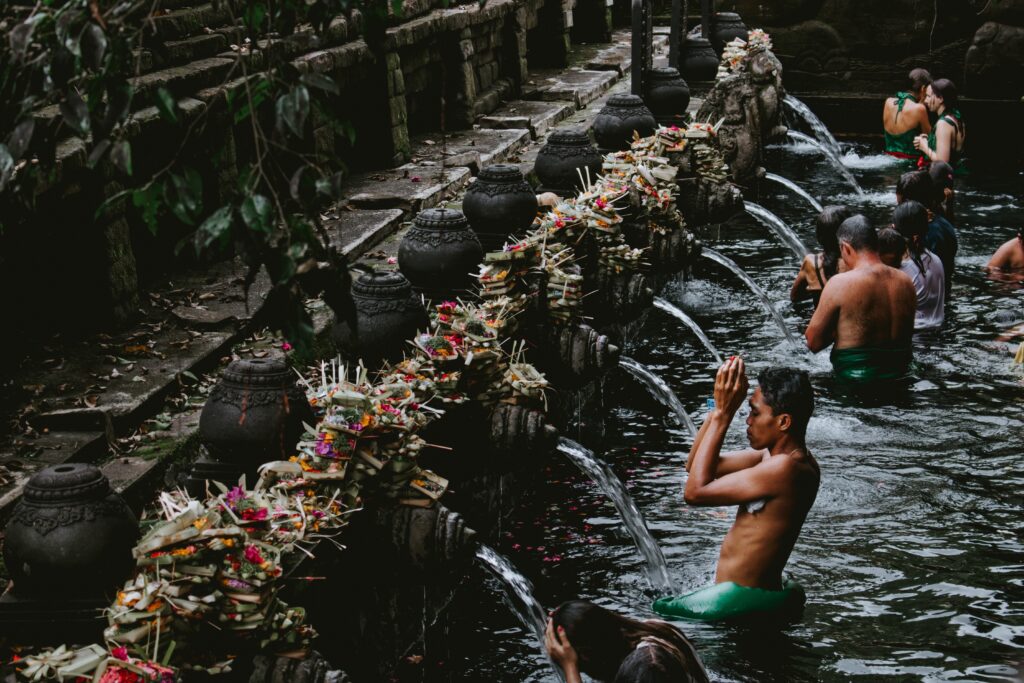
- Segehan – sees locals make offerings to protect themselves against the malevolent spirits that seek to do them harm.

Temple sweeping – prior to any major festival, the temple is swept. Not to keep it clean but to purify the energy of the place and ensure the desired outcomes of any rituals that will take place.

Personal prayers – Hindus come to the temple to reconnect with the gods and themselves and may enter prayer or meditation at any time in any place in the temple.
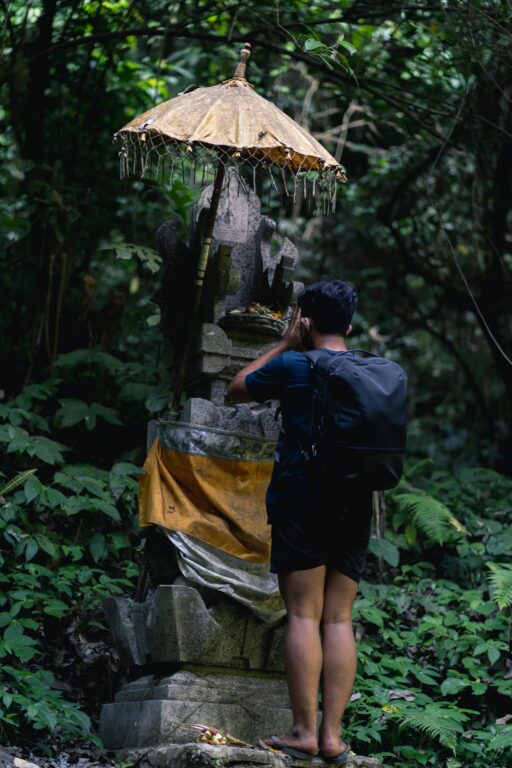
The Monkeys Of Lempuyang Temple
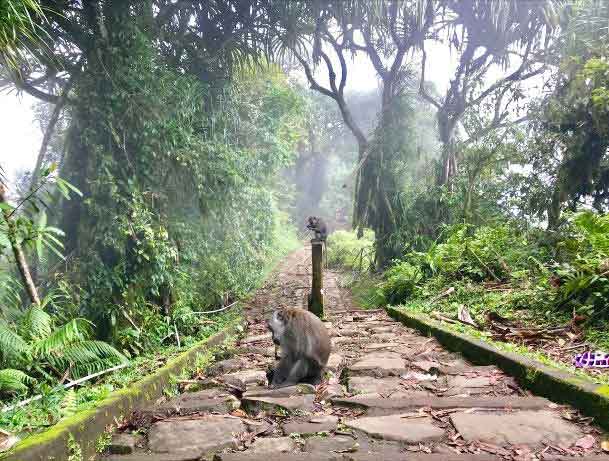
Yes, there are monkeys at Lempuyang Temple, and sadly, like monkeys elsewhere in Bali, they can be a bit of a pain in the neck.
The long-tailed macaques are both curious about visitors and straight-up mischievous as well.
They will steal food and shiny things if you allow them to get too close to you, and if they do, please don’t fight the monkeys.
Monkeys don’t fight fairly, and they will bring all their friends to pile on. Worse, their bite might carry rabies, and rabies prevention treatment is very expensive in Bali.
If you do have an issue with a monkey, you may have to let the monkey win, and you can also talk to a local guide (assuming you have one) and have them see if they can intercede to get your property back (there are no guarantees that they can).
It’s best to keep your distance from the temple’s monkeys if you want to have a good time.
Travel Tips For Pura Lempuyang Temple

We’ve got some simple tips that can help you get the most out of your time at this temple:
-
Dress comfortably but modestly – remember this is a place of worship, first and foremost.
-
Lower your voice, don’t swear – again, it’s a holy place.
-
Take a guided tour – you will get much more out of your visit to this temple if you have someone who can explain the history, rituals, and culture to you.
-
Use the shuttle service – there’s a lot of walking to be done anyway, so don’t make it harder on yourself. The shuttle isn’t expensive.
-
Allow enough time – this is a big complex, so don’t race around, give yourself enough time to relax and appreciate it
-
Talk to the locals – they will be delighted to help you understand the importance of the temple to their community
-
Get there early if you can – there will be fewer crowds around
-
Check the weather – won’t let rain deter you from visiting, but do bring an umbrella and a jacket if it looks like rain and give yourself a little bit more time to explore, too
Dress Code For Lempuyang Temple In Bali
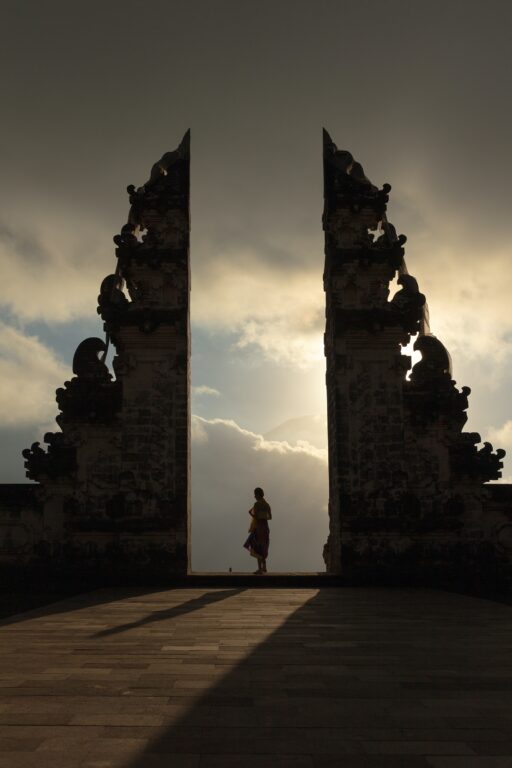
It’s important to respect Balinese beliefs when you’re visiting temples in Bali, and that means obeying the dress code at religious sites.
You need to cover your shoulders and legs when in the complex for a hassle-free trip, and if you need to, you can rent a sarong and a shawl at the entrance.
Photographic Tips For When You Visit Lempuyang Temple
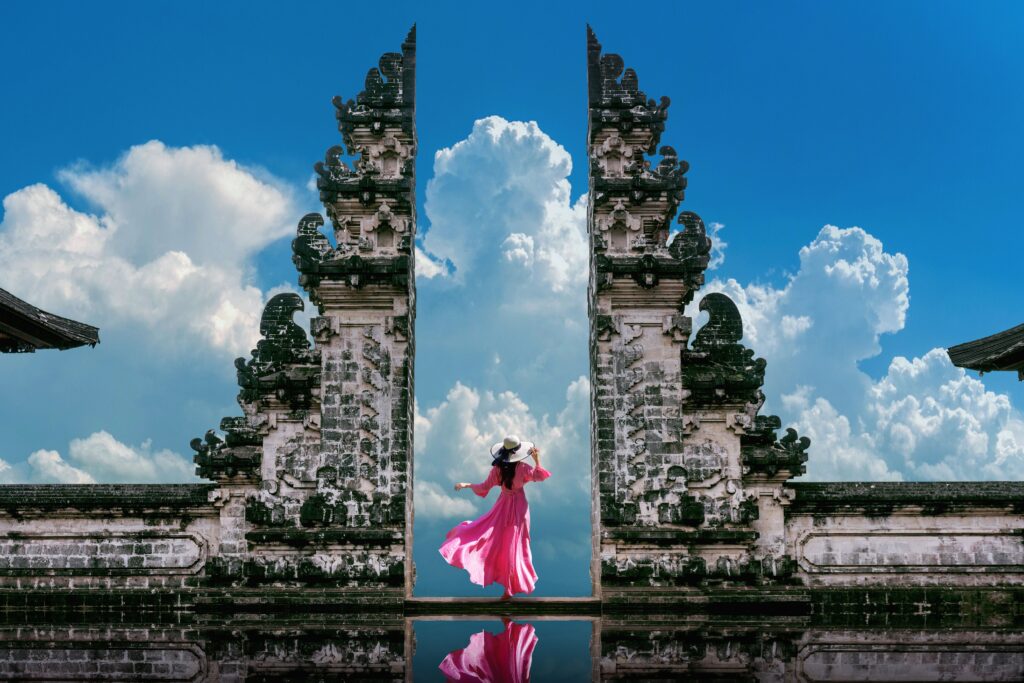
You’ve probably seen one of those awesome Instagram photos of someone standing in the Gates of Heaven reflected in a pool below it.
There is no pool at the temple, nor is there any water in front of the Gates of Heaven.
The local photographer (the one included in your entrance fee) has a mirror holder, and he uses a mirror to create this effect.
It looks awesome, but it’s an optical illusion, not the real thing.
If you brought your camera to this part of East Bali, you wouldn’t get to exercise it at the Gates of Heaven (because that’s somebody’s job), but you can shoot anywhere else and get the best shots:
Consider bringing a wide-angle lens – this is the best way to capture the architecture of the site and get some attractive landscapes. It makes taking photos at this site much easier.
Consider bringing a telephoto lens, too – this can do a great job of bringing a landscape image together and allow you to photograph things that would otherwise be too far away
Bring a tripod – the best images come from a steady shooting position. A light travel tripod is fine. Just try not to get in other people’s way with it. Taking photos with a tripod makes a huge difference to the end result.
Consider ND and CPL filters – these can help you get long-exposure shots (think fluffy clouds) and get the best blue from the sky.
Don’t take pictures of people praying – it’s rude and can cause arguments. Balinese Hindus see Lempuyang Mountain as a sacred place and not just as a famous photo spot, and there’s room for everyone as long as everyone is courteous.
Don’t climb on things to get better photos – sure, you want that perfect shot of the doorway of Pura Lempuyang Luhur, that’s fine, but you can’t climb on sacred sites to get it
Don’t use flash indoors – it’s better to slow your shutter, open your aperture wide and crank the ISO. That way, you won’t annoy anyone.
Attractions Near The Mount Lempuyang Temple
There are several other attractions within a short drive of the temple, and your tour or private car should be able to incorporate any or all of them in your visit:
Tirta Gangga Water Palace & Jungle Swing – this attractive royal retreat is serene and pleasant. It’s also just around the corner from one of the most famous jungle swings in Bali.

- Ujung Water Palace – This sprawling royal palace has one of the most attractive water features in Bali.

- Tegalalang Rice Terraces – the rice terraces of Bali are really something to behold, and Tegalalang offers a wealth of natural beauty to visitors.

- Pasir Putih Beach – this white sand beach is truly pristine and a long way from the crowds on more popular beaches.
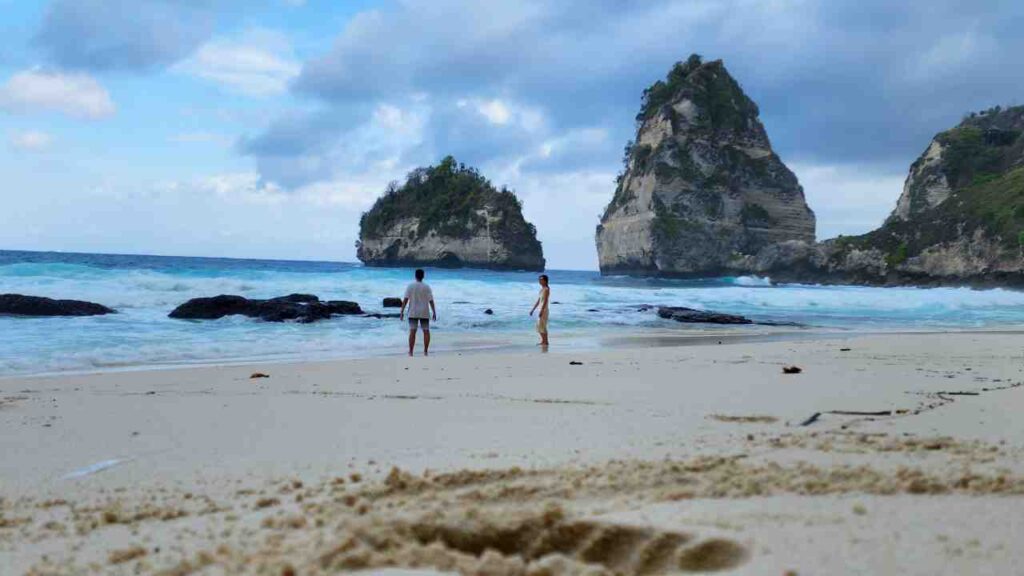
Teganang Village – this is one of the best places to experience traditional Balinese life and it’s known for its amazing weavers.
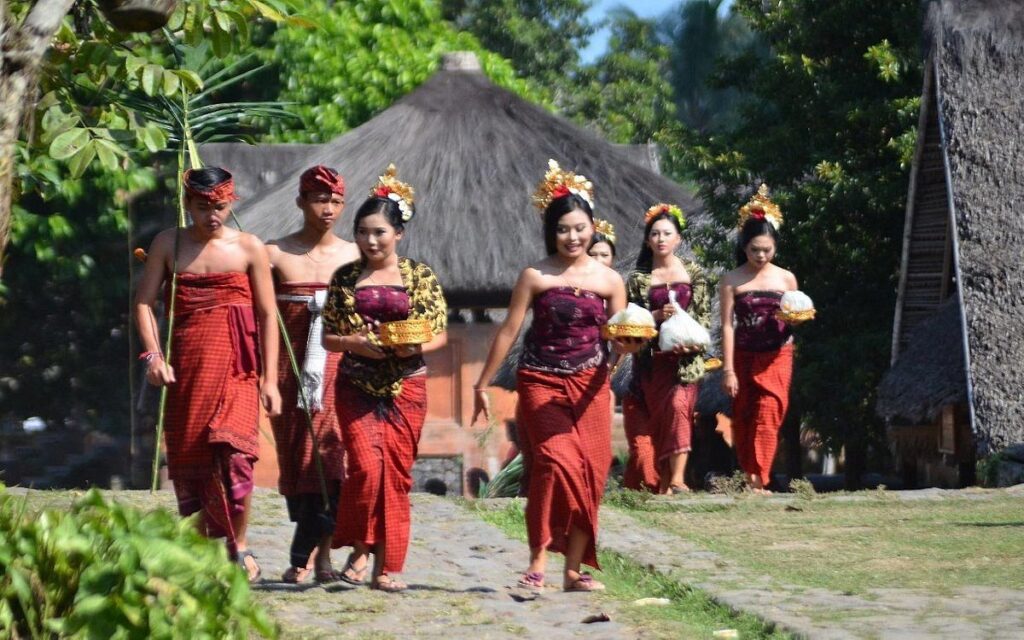
FAQs
Is Going to Lempuyang Temple Worth It? Are The Gates Of Heaven Worth It?
Yes! Lempuyang Temple in Bali is one of the most spectacular and spiritual sites on the island.
The architecture on display is incredible. The Gates of Heaven, Bali, are not just the ideal Instagram moment but a reminder of the connection between the human and the divine.
Climbing the steps at this temple provides you with a sense of personal achievement, and the journey provides time to enjoy each layer of temples and the amazing vistas from each one.
We think that visiting Lempuyang Temple is likely to leave a permanent and positive impression in your memory for years to come.
It’s one of the most highly regarded temples for tourists visiting Bali for good reason.
Why Is Lempuyang Temple Famous?
The temple is a sacred place and one of the six holiest sites on the island, and it represents the phases of spiritual ascent as you climb Mount Lempuyang to reach the top.
However, perhaps the most famous part of the entire temple complex is the Gates of Heaven, Bali. Visiting Pura Lempuyang is always enshrined in amazing photos of this extraordinary place.
How Many Steps Are At Lempuyang Temple?
We haven’t been able to get an exact count ourselves, and every source we turn to has a different number.
However, we can say with relative certainty that there are about 1,700 steps between the temple’s entrance and the top of the mountain.
It’s fair to say that this can be very physically demanding, and we would encourage you to take your time when tackling the climb.
You can stop at any of the seven temples on the way up and catch your breath and get a drink of water (bring your own water, there are no shops at the temples).
Once you reach the top, you will be rewarded with an amazing view, a real sense of achievement and the opportunity to appreciate the serene and spiritual environment as it was meant to be appreciated.
How Long Should We Spend At Lempuyang Temple?
That’s very much down to you. Not everyone climbs the mountain, and if you’re just going to hit the Gates of Heaven, grab a photo and move on, you won’t need more than an hour.
However, we think you’ll get more out of your visit to this temple if you slow down a little and take time to explore, climb to the top (and back down again) and enjoy the architecture, mountain-top views, and more.
We would point out that if you undertake the climb, unless you’re in peak physical condition, it’s quite a long way, and you should be prepared to allocate some time for resting, not just climbing.
We would recommend that you spend 2-4 hours here if you want to maximize the experience (and given that it’s quite a long way to come from the beach towns, it’s a shame to hurry around and then out again).
What Do You Wear To Lempuyang Temple?
There is a standard requirement to dress modestly at all Balinese temples, and this one is no exception.
You are expected to cover both your shoulders and your legs inside the temple grounds, and the locals do this by means of a shawl and a sarong.
If you do not have appropriate clothing, you can buy or rent it at the entrance before you take the shuttle bus. You won’t be allowed onto the grounds if you’re not dressed properly.
We should also note that women who are menstruating are not meant to enter the grounds of any temple in Bali.
Hinduism considers women in this state to be “unclean” and their presence to defile the temple.
Do I Need A Guided Tour At Lempuyang Temple?
You don’t have to use the services of a guide at the temple. However, we think that a guide can be an invaluable addition when exploring historical sites like this one.
They can help you understand the meaning of the things you see and explain the historical, religious and cultural significance of the place.
While there are many sites in Bali where you can probably skip a guide without missing out on anything, we think Lempuyang Temple is a good place to visit with a guide.
How do you book a trip to Pura Lempuyang Temple, Bali?
If you want to see the Gates of Heaven, Pura Lempuyang Luhur or the larger area of East Bali during your time in Bali, we recommend that you contact the awesome people at the Bali Res Centre.
They can arrange a guided tour of the most interesting places on the island for you, including Mount Lempuyang.
The service is also happy to arrange flights, accommodation and other travel-related services in Bali.
What we like most about Bali Res Centre is that it’s locally owned and operated, and when you deal with them, you’re supporting the Balinese economy.
Final Thoughts On The Pura Lempuyang Temple Complex
Pura Lempuyang Temple in East Bali is an amazing sight, and the Gates of Heaven, Bali, is a cultural icon for a good reason.
If you want to learn more about the culture, history and spiritual side of island life, we can strongly recommend a visit to the temple and the surrounding area.


